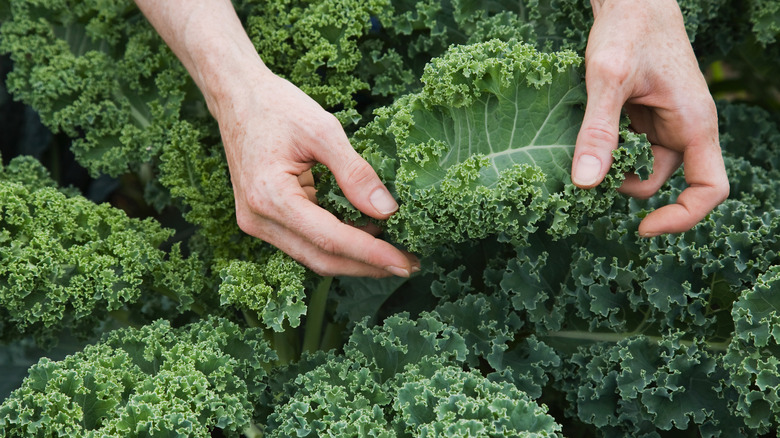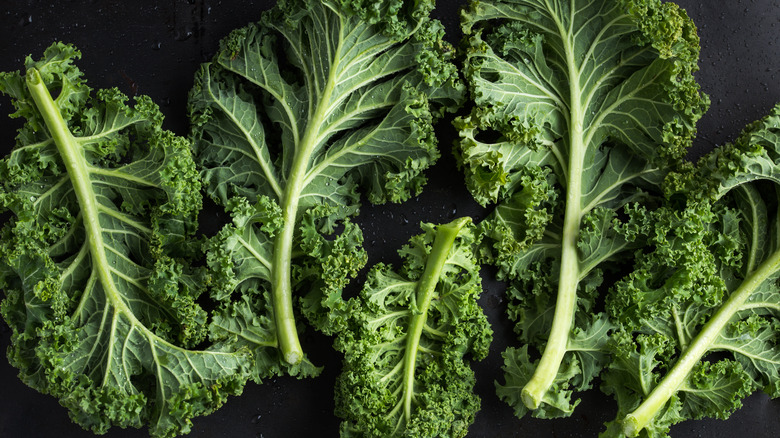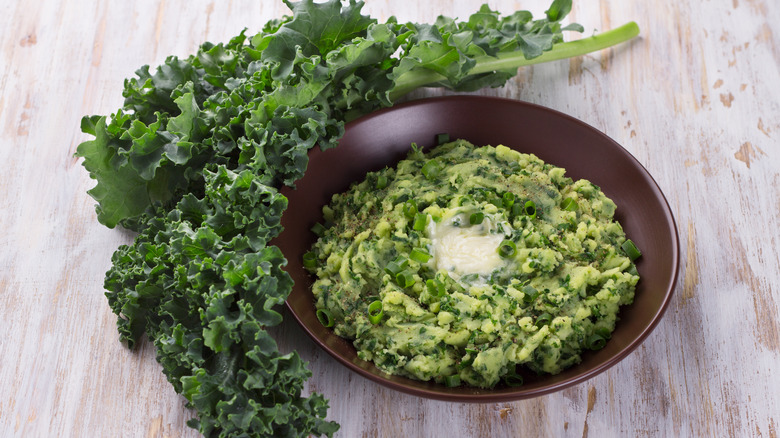Why Kale Was Once A Halloween Staple
While leafy, green kale may not be the first thing that comes to mind when you think about Halloween, it was at one time an important part of celebrating the holiday. Long before trick-or-treating for candy influenced what Americans ate on Halloween, festivities involving kale were popular with young people throughout the British Isles. Halloween, as we know it today, derives from the far older pagan holiday Samhain, which was observed by the Celts to signal the coming of winter and the start of the new year. They believed it was when the dead could pass into the realm of the living, making it a powerful time for divination — not with crystal balls, but with leaves and stalks of kale.
Kale has likely been grown in Scotland and Ireland since the Middle Ages, but its use as a divination tool was first written about in the 18th century. The revered Scottish poet Robert Burns wrote about the practice of "kaling" in his 1785 poem, "Hallowe'en." It detailed the holiday's traditions, games, and pranks that were popular at the time, and its publication helped the folklore described in the poem to spread.
Because it was easy to cultivate, kale, like its cousin cabbage, was a crop that even the poorest subsistence farmers could grow. Considering its place in the holiday's history, it is not surprising that kale's harvest peak coincides with Halloween. Kale was once a common Halloween staple — not just as a food, but also for fortune-telling and matchmaking.
Destiny revealed on Halloween night
In the 18th and 19th centuries, methods of clairvoyance using kale centered around romance — namely, young men and women hoping to learn the identity of their future mates. Elaborate rituals took place at the midnight hour, and there were complex rules for interpreting kale's message. One example of kaling was known as "pou (pull) the stalks" as mentioned in the Rabbie Burns poem and described in the book, "Halloween: Romantic Art and Customs of Yesteryear" by Diane C. Arkins. In the dark of night, intrepid participants were blindfolded and led into a field of kale (called a kaleyard). After feeling around in the dark, they would pull a stalk of kale from the ground, which was then analyzed to determine its meaning.
If the stalk was easy to yank out, it signified that the one who pulled it would have an easy time finding a spouse, but if it had been tough to extract, their search for love would be difficult. A stalk with abundant, bushy leaves meant the person's future match would be good-looking — while a withered plant warned of a miserly husband or wife. If the roots had plenty of dirt attached, one could expect a happy marriage, while a dirt-free root foretold the opposite. The shape of the plant corresponded with a future lover's appearance — tall, stumpy, thin, or thick. The plant's taste was significant too: Mild, sweet, bitter, or dry flavor would indicate the mystery partner's personality.
How kale foretold a bitter or sweet future
In "Samhain: Rituals, Recipes & Lore for Halloween" by Diana Rajchel, the author explains that the pulled kale stalks were hung from doorways, and the first person to walk under one could take it to be placed under their pillow for a glimpse into their future in a dream. Similar tales involved women hanging the stalks from the rafters, each with the lady's chosen numbers inscribed on them. When a man walked under her marked stalk, the first letter of his name signified the first initial of her future husband's name.
In a related ritual, a woman would cook the traditional Irish dish of colcannon for Halloween and fill a stocking with some of the mixture. The stocking would be nailed to her home's front door, and whichever man was next to enter (excluding her family, of course) was said to be whom she would marry.
Colcannon is a dish made with mashed potatoes, cabbage, and kale, and it was as integral to the celebration of Halloween as was kaling in the fields. The eating and cooking of it was itself a part of the divination process. When it was being cooked, a small charm was hidden inside of it before serving. Getting a coin indicated good fortune while finding a thimble meant one would be single all their life. Biting into a ring meant its recipient would soon marry, the original version of getting lucky.



